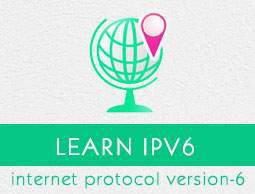The successor of IPv4 is not designed to be backward compatible. Trying to keep the basic functionalities of IP addressing, IPv6 is redesigned entirely. It offers the following features:
Larger Address Space
In contrast to IPv4, IPv6 uses 4 times more bits to address a device on the Internet. This much of extra bits can provide approximately 3.4×1038 different combinations of addresses. This address can accumulate the aggressive requirement of address allotment for almost everything in this world. According to an estimate, 1564 addresses can be allocated to every square meter of this earth.
Simplified Header
IPv6’s header has been simplified by moving all unnecessary information and options (which are present in IPv4 header) to the end of the IPv6 header. IPv6 header is only twice as bigger than IPv4 provided the fact that IPv6 address is four times longer.
End-to-end Connectivity
Every system now has unique IP address and can traverse through the Internet without using NAT or other translating components. After IPv6 is fully implemented, every host can directly reach other hosts on the Internet, with some limitations involved like Firewall, organization policies, etc.
Auto-configuration
IPv6 supports both stateful and stateless auto configuration mode of its host devices. This way, absence of a DHCP server does not put a halt on inter segment communication.
Faster Forwarding/Routing
Simplified header puts all unnecessary information at the end of the header. The information contained in the first part of the header is adequate for a Router to take routing decisions, thus making routing decision as quickly as looking at the mandatory header.
IPSec
Initially it was decided that IPv6 must have IPSec security, making it more secure than IPv4. This feature has now been made optional.
No Broadcast
Though Ethernet/Token Ring are considered as broadcast network because they support Broadcasting, IPv6 does not have any broadcast support any more. It uses multicast to communicate with multiple hosts.
Anycast Support
This is another characteristic of IPv6. IPv6 has introduced Anycast mode of packet routing. In this mode, multiple interfaces over the Internet are assigned same Anycast IP address. Routers, while routing, send the packet to the nearest destination.
Mobility
IPv6 was designed keeping mobility in mind. This feature enables hosts (such as mobile phone) to roam around in different geographical area and remain connected with the same IP address. The mobility feature of IPv6 takes advantage of auto IP configuration and Extension headers.
Enhanced Priority Support
IPv4 used 6 bits DSCP (Differential Service Code Point) and 2 bits ECN (Explicit Congestion Notification) to provide Quality of Service but it could only be used if the end-to-end devices support it, that is, the source and destination device and underlying network must support it.
In IPv6, Traffic class and Flow label are used to tell the underlying routers how to efficiently process the packet and route it.
Smooth Transition
Large IP address scheme in IPv6 enables to allocate devices with globally unique IP addresses. This mechanism saves IP addresses and NAT is not required. So devices can send/receive data among each other, for example, VoIP and/or any streaming media can be used much efficiently.
Other fact is, the header is less loaded, so routers can take forwarding decisions and forward them as quickly as they arrive.
Extensibility
One of the major advantages of IPv6 header is that it is extensible to add more information in the option part. IPv4 provides only 40-bytes for options, whereas options in IPv6 can be as much as the size of IPv6 packet itself.


